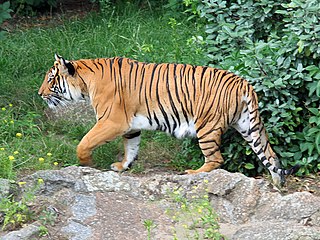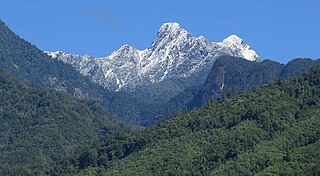
The clouded leopard, also called mainland clouded leopard, is a wild cat inhabiting dense forests from the foothills of the Himalayas through Northeast India and Bhutan to mainland Southeast Asia into South China. It was first described in 1821 on the basis of a skin of an individual from China. The clouded leopard has large dusky-grey blotches and irregular spots and stripes reminiscent of clouds. Its head-and-body length ranges from 68.6 to 108 cm with a 61 to 91 cm long tail. It uses its tail for balancing when moving in trees and is able to climb down vertical tree trunks head first. It rests in trees during the day and hunts by night on the forest floor.

Pangolins, sometimes known as scaly anteaters, are mammals of the order Pholidota. The one extant family, the Manidae, has three genera: Manis, Phataginus, and Smutsia. Manis comprises four species found in Asia, while Phataginus and Smutsia include two species each, all found in sub-Saharan Africa. These species range in size from 30 to 100 cm. A number of extinct pangolin species are also known. In September 2023, nine species were reported.

The ground pangolin, also known as Temminck's pangolin, Cape pangolin or steppe pangolin is a species of pangolin from genus Smutsia of subfamily Smutsiinae the within family Manidae. It is one of four species of pangolins which can be found in Africa, and the only one in southern and eastern Africa. The animal was named for the Dutch zoologist Coenraad Jacob Temminck.

The Formosan black bear, also known as the Taiwanese black bear or white-throated bear, is a subspecies of the Asiatic black bear. It was first described by Robert Swinhoe in 1864. Formosan black bears are endemic to Taiwan. They are also the largest land animals and the only native bears (Ursidae) in Taiwan. They are seen to represent the Taiwanese nation.

Manis ("spirit") is a genus of South Asian and East Asian pangolins, the Asiatic pangolins, from subfamily Maninae, within family Manidae.

Manidae ("spirits") is the only extant family of pangolins from superfamily Manoidea. This family comprises three genera, as well as extinct Fayum pangolin.

The Formosan clouded leopard is a clouded leopard population that was endemic to Taiwan. Camera trapping studies carried out in several protected areas in Taiwan between 1997 and 2012 did not record any clouded leopard. The population is listed as extinct on the IUCN Red List.

The Indochinese tiger is a population of the Panthera tigris tigris subspecies that is native to Southeast Asia. This population occurs in Myanmar and Thailand. In 2011, the population was thought to comprise 342 individuals, including 85 in Myanmar and 20 in Vietnam, with the largest population unit surviving in Thailand, estimated at 189 to 252 individuals during the period 2009 to 2014.

The Sumatran tiger is a population of Panthera tigris sondaica on the Indonesian island of Sumatra. It is the only surviving tiger population in the Sunda Islands, where the Bali and Javan tigers are extinct.

The Indian pangolin, also called thick-tailed pangolin and scaly anteater, is a pangolin native to the Indian subcontinent. Like other pangolins, it has large, overlapping scales on its body which act as armour. The colour of its scales varies depending on the colour of the earth in its surroundings. It can also curl itself into a ball as self-defence against predators such as the tiger. It is an insectivore feeding on ants and termites, digging them out of mounds and logs using its long claws, which are as long as its fore limbs. It is nocturnal and rests in deep burrows during the day.

The Sunda pangolin, also known as the Malayan or Javan pangolin, is a species of pangolin. It is a member of the Manidae family. Its English name comes from the Malay name "pëngulin", which means "roller".

The Taipei Zoo, sometimes referred to as the Muzha Zoo, is a public zoological garden in Wenshan District, Taipei, Taiwan. It is the most famous zoological garden in Taiwan and a leader in conservation, research and education, and recreation. It is one of the largest zoos in Asia, with a total area of 165 hectares, of which more than 90 ha are developed.

Owston's palm civet is a viverrid native to Vietnam, Laos and a very small portion of southern China, in three counties located in the Yunnan province: Hekou, Luchun, and Jinping, and has never been found west of the Mekong River. It is listed as endangered on the IUCN Red List because of an ongoing population decline, estimated to be more than 50% over the last three generations, inferred from over-exploitation, habitat destruction and degradation.

The Chinese pangolin is a pangolin native to the northern Indian subcontinent, northern parts of Southeast Asia and southern China. It has been listed as Critically Endangered on the IUCN Red List since 2014, as the wild population is estimated to have declined by more than 80% in three pangolin generations, equal to 21 years. It is threatened by poaching for the illegal wildlife trade.

The Philippine pangolin or Palawan pangolin, also locally known as balintong, is a pangolin species endemic to the Palawan province of the Philippines. Its habitat includes primary and secondary forests, as well as surrounding grasslands. This species is moderately common within its limited range, but is at risk due to heavy hunting because of its valued scales and meat. This species is distinguished from the closely related Sunda pangolin by its smaller body-to-tail ratio, smaller scales, and a shorter head. It is listed as Critically Endangered by the IUCN, and Critically Endangered by the Palawan Council for Sustainable Development (PCSD).
The Kulamba Wildlife Reserve is situated in Sabah, Malaysia, and covers 204 km2 (79 sq mi). It is an area protected under state law and is particularly significant for the conservation of orangutans.

The pangolin trade is the illegal poaching, trafficking, and sale of pangolins, parts of pangolins, or pangolin-derived products on the black market. Pangolins are believed to be the world's most trafficked mammal, accounting for as much as 20% of all illegal wildlife trade. According to the International Union for Conservation of Nature (IUCN), more than a million pangolins were poached in the decade prior to 2014.
Mahamyaing Wildlife Sanctuary is a protected area in Myanmar's Sagaing Region, covering an area of 1,181 km2 (456 sq mi). It ranges in elevation from 145 to 590 m and was established in 2002 in Kalay and Mawlaik Townships.

Imawbum National Park, also known as Emawbum National Park, is a national park in northern Myanmar. The park was designated in 2020, and covers an area of 149,103 acres (603.40 km2). It is located in eastern Kachin State, and on the east it adjoins the border with China.

















